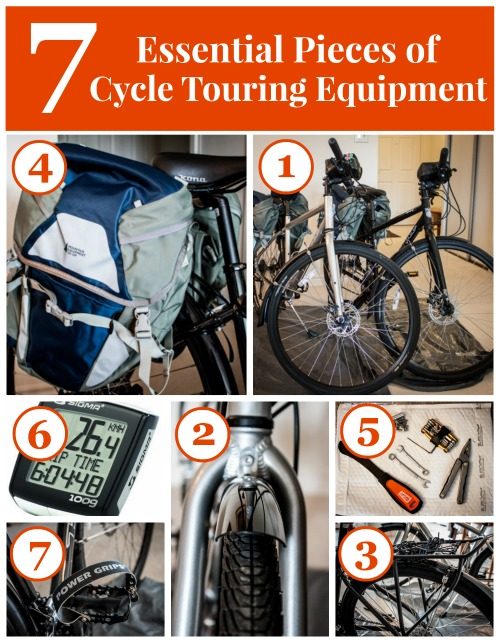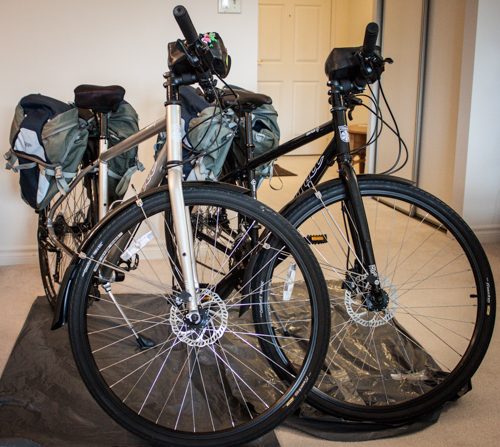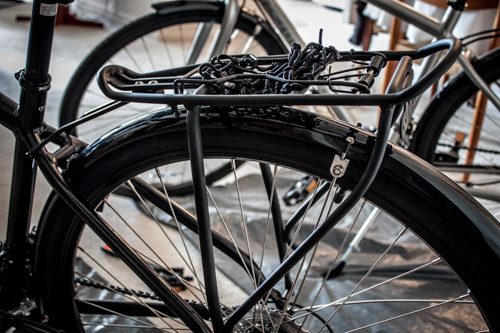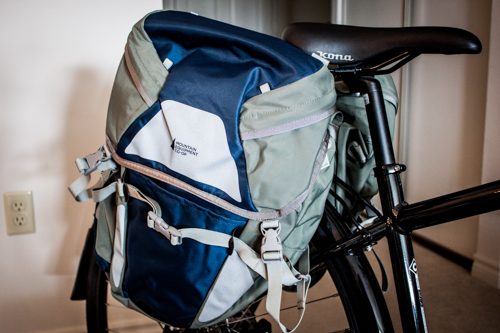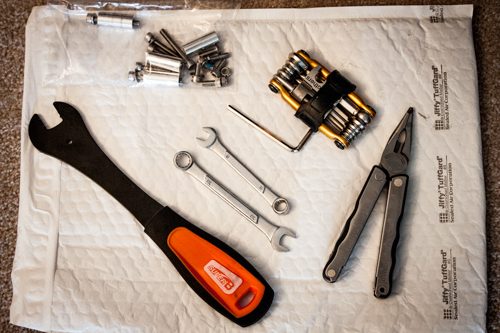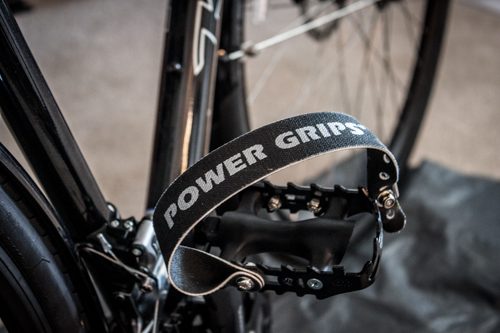Equipment
While we’re obviously not cycle touring experts….yet…even we know that there is just some cycle touring equipment that you can’t tour without.
There is a whole lot of geekdom surrounding bike gear and you can spend hours searching through the should’s and shouldn’ts of bike gear. We’ve taken a much more relaxed approach; I think that you don’t have to spend big money in order to get equipment that will do the job. Of course we’ll have to see how this all works out – I’ll report back once we get on the road and let you know how it’s all holding up.
Cecilia is on the left. Bartholomew on the right.
1. Bike. This is, by far, the most expensive piece of cycle touring equipment and it’s easy to go crazy, and spend a lot of money, trying to find the perfect bike. I’m not saying that the expensive ‘touring bikes’ that are available aren’t worth it. I bet they are extremely durable and offer a smooth ride for many, many miles but we just don’t have the money to invest in high end bikes.
I have ridden Kona bikes exclusively for many, many years. I started mountain biking in 1998 and my very first bike was a Kona Cinder Cone. As my skills increased, and bike technology evolved, I replaced it with a Kona Stinky in 2002. I loved that bike; I named him Frank and we spent many good years together. I sold Frank in 2007 and picked up Gus; a beautiful green Kona Coil Air. With this bike I could do anything I wanted to do – we rode up countless hills together and ripped down them even faster. It was with a heavy heart that I put him up for sale in 2012 but it was the biggest sign of commitment to our new plan that I could muster. It was worth losing him but I can’t tell you how much I miss spending my Sunday mornings riding with the guys.
And so when looking for affordable cycle touring bikes the first place I looked was Kona. Kona has some great bikes specifically made for cycle touring but they were far out of our price range. They do, however, have a good commuter/hybrid option that looked like it would be perfect; durable enough to get through the tour, not too heavy even when fully loaded, and at under $700 we could manage the cost. The Kona Dew Plus should serve us well.
Meet Cecilia (my bike) and Bartholomew (Jason’s). Yep, we have matching bikes. It seemed silly to find two different bikes when we found the one that would work. And yes, I always name my bikes; the name just comes to me. This is the first girl bike I’ve had.
2. Fenders. I’ve never had fenders on a bike before. Getting muddy was always part of the fun in mountain biking. But, when riding for hours on end trying to make up miles, we are not going to want road spray mucking us up. I’m sure there are some high end, super duper, fenders out there but we went with this basic version from Mountain Equipment Coop (MEC; our Canadian version of REI). These from Amazon.com look just the same.
3. Racks. As we won’t be camping during this trip we really only need rear panniers so we only needed a rear rack to hold those panniers. We happened to order ours from Wiggle.com – they had the bicycle packing bags we were looking for and we needed to bolster our order so got our racks there too – again, these from Amazon.com look very similar. It’s worth noting that if your bike has disc brakes that you ensure that the rack can accommodate mounting around them.
4. Panniers. Ortlieb panniers are the gold standard in cycle touring. They are tough, durable, waterproof, and expensive. We did not get Ortlieb panniers. In fact, for the price of one set of Ortlieb panniers we picked up two sets of MEC panniers (on sale). At 56L per set we will have more than enough room for all the gear we plan on carrying plus they have plenty of pockets and straps to allow for organization which I like. They are not, however, waterproof. We have waterproof bags for our electronics and plan on finding a plastic liner to help keep the rest of our stuff dry-ish.
5. Tools. We’re lucky. Although we’ll be cycling self-supported we are also cycling in one of the most bike friendly areas on earth. You can’t go far in Europe without hitting a town, and a bike shop. This means we don’t have to carry all the tools and parts necessary to completely rebuild a bike (like, say, if you were biking in Asia or South America). We do, however, need to be able to do basic repairs, tire changes, and do emergency McGiver repairs if need be.
We’ll have a basic tool kit with us:
- A chain maintenance kit with chain lube, a brush, and rag.
- A cycle specific multi-tool with various screw driver heads, allen keys, and a chain break.
- A basic leatherman tool with pliers, knife, and screwdriver heads.
- A regular multi-tool with scissors, small knife, and tweezers.
- A couple of bike specific sized wrenches.
- A folding knife.
- A patch kit with patches and glue along with tire levers to get the tire off the rim.
- A pedal wrench for removing the pedals if we decide to ship the bikes ahead at any time.
- And a corkscrew; although I don’t think that’s bike specific 😉
6. Bike Computer. Probably not essential but how else are we going to know how far we went, how long it took, and how fast we were? We got just a very basic version but you can go all out and get elevation and GPS trackers too if you like.
7. Power Grips. What, you ask? Well, most long-haul cyclists ride ‘clipped in’. This means there are special clips on the bottom of their shoes that attach their feet to the pedals. Being ‘clipped in’ to the bike is a much more powerful way to ride as you can pull up with your rising pedal as you push down on the downward pedal. It’s like having little wings on your feet to help you get up the hills. However, this means that the shoes you cycle in can only be used to cycle in; the metal clip on the bottom makes using them useless as walking or hiking shoes and so you must carry ‘regular’ shoes also. This is added packing and also added expense – not only for the special shoes but also for the special pedals.
The other, much older, option are toe cages; metal cages that attach to the pedal and into which you can slip the toe of your shoe into. A little clunkier, and not as powerful as being clipped in, but better than nothing.
But then I stumbled on these Power Grips. They’re like the best of both worlds. They work with regular shoes like toe cages do but they strap your foot in much more strongly and so offer much better power than toe cages. I’ve never actually used them before but by all accounts they should really work. I’ll let you know how it goes. Note: we ordered the Power Grips kit and were surprised when it came complete with pedals. We should have ordered just the straps and attached them to our own pedals; that would have saved money.
**********
Read all the other posts in our pre-trip Cycle Tour Europe series:




